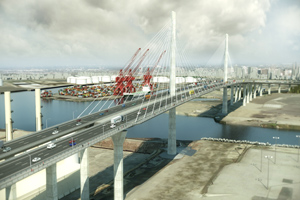Work Begins on $1 Billion Bridge to Upgrade Long Beach Port Access

This story appears in the Jan. 14 print edition of Transport Topics.
A pair of announcements about developments at the nation’s two largest ports holds the promise of helping southern California truckers.
Construction began Jan. 8 on a four-year, $1 billion program to replace the aging Gerald Desmond Bridge along the main route to the Port of Long Beach, the second-largest U.S. port.
“This bridge is vital to freight movement and the nation’s economy,” said Federal Highway Administrator Victor Mendez in a ceremony under the 44-year old bridge. “The project will also relieve congestion on the road network that directly serves one of the nation’s busiest ports.”
The other announcement disclosed an effort by PierPass Inc. to immediately speed up 1,500 truck moves a day at the Port of Los Angeles and Port of Long Beach.
The new bridge will be 515 feet above the water, adjacent to the existing span that will be demolished when the new one is completed. Traffic will keep moving on the old bridge, used by more than 15,000 trucks daily, during construction.
“A new bridge is vital to our port tenants, to our communities and to businesses around the world that depend on us to move their goods,” said Port of Long Beach Executive Director Christopher Lytle.
Federal, state, county and port funds are supporting the project, which includes about $650 million for construction and the balance for costs such as site preparation and demolition.
Construction began with installation of a steel casing 5 feet in diameter to test bridge foundations.
As for the 1,500 trucking moves, currently they are slowed by “trouble tickets,” which result from incorrect information about a load’s availability, such as a Customs hold on the cargo.
On average, those loads take an extra hour to handle, more than doubling the average time of 51 minutes for a typical shipment, PierPass said. The 51 minutes includes waiting time at the gate and pickup within the port.
But Bruce Wargo, CEO of PierPass, said the group is launching an educational campaign to have truckers check to make sure they have accurate information about cargo in advance to prevent trouble tickets.
“We are always looking at things we can do to improve the flow of cargo and make sure it is moving efficiently,” he said, calling those tickets “a substantial issue that has to be addressed.”
Delays caused by trouble tickets affect other truckers who have to wait in line behind a driver whose load can’t move, Wargo said.
Trouble tickets affect about 5% of port moves in California and nationwide, based on a 2011 report.
PierPass was formed seven years ago by terminal operators seeking to alleviate congestion at port gates. The plan levies a fee — currently $123 per 40-foot container — for each shipment moved between 3 a.m. and 6 p.m. weekdays. The charge is waived for shipments at other times in an effort to spread out truck traffic.
Wargo spoke with reporters on Jan. 9, about a month after an eight-day strike by clerical workers belonging to the International Longshore and Warehouse Union was ended following intervention by federal mediators.
“It took a little over a week to clear out the cargo built up on the docks” during the strike, said Wargo. Shifts were added at several terminals to help eliminate the backlog, he said.
“Cargo movements seem to be very normal for this time of year,” Wargo told TT, with 55% of freight moving at night. “I would expect a slight rush to arrive before the Lunar New Year and then a slow period for a few weeks before getting back to normal.”
Lunar New Year, when Asian factories typically are closed for two weeks, falls on Feb. 10 this year.
All but 14% of port moves are completed within two hours from the time a driver gets in line until departure from the terminal, PierPass said in a statement.

